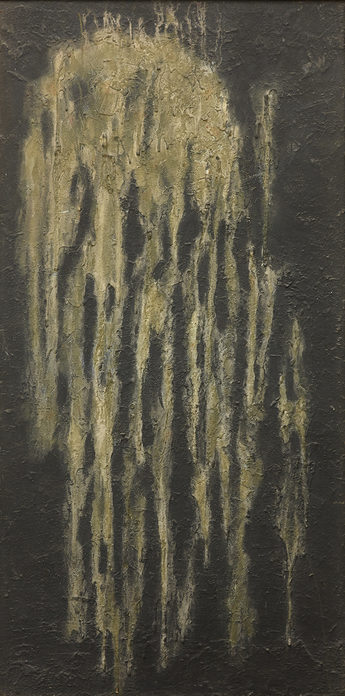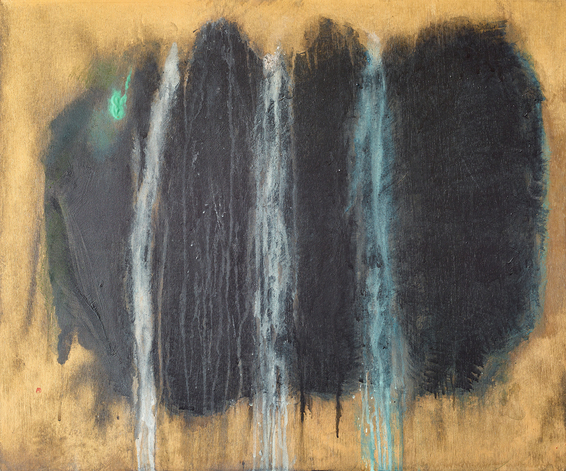-
From Current Issue
-
- Editor’s Letter Fire in the Heart
- Reviews I Gusti Ayu Kadek Murniasih
- Reviews 11th Seoul Mediacity Biennale: “One Escape at a Time”
- Dispatch Networked China
- One on One Monira Al Qadiri on Yukio Mishima
- Essays The rise of independent art spaces in pandemic-era Shanghai
- Features Tuan Andrew Nguyen
- Table of Contents
- Web Exclusives
- Archive
- Subscribe

R
E
V N
E
X
T
Before his death in 2014, Ryuji Tanaka’s work had taken several directions, and yet with each new adjustment in the course of his practice he retained some element of the work he had made before. His point of departure, which remained prominent throughout his career, was nihonga–Japanese-style paintings–which he studied at the Kyoto Municipal School of Painting in the years immediately following the Second World War. Japanese culture, and this long-established painting style with its focus on the use of traditional techniques and materials such as ground mineral pigments, sumi ink made from pine soot, paper and silk, was undergoing a post-bellum crisis that instigated reflections such as the nihonga metsubō-ron (”theory on the death of nihonga”). Consequently, a number of artists formed groups to reassess the state of the art form, including the avant-garde Pan-real Art Association, formed in 1948, of which Tanaka was briefly a member.
None of the paintings from this early period featured in Simon Lee gallery’s recent survey of Tanaka’s works, the first posthumous solo exhibition in the United Kingdom. However, his creations from subsequent years remain fine examples of both his dedication to the materiality of nihonga and his avant-garde sensibilities.
Working on wooden panels and—contrary to the traditions of nihonga—canvas, Tanaka underwent a period of intense productivity at the beginning of the 1960s. In Sei (ii) (1962-1966) and Sei (6) (1962), painted on panel and canvas respectively, he presents the aesthetic that had become central to his practice, where applications of light pigment sit at the nucleus of darkly painted planes. The artist is known for adding extraneous matter, like pebbles and ground glass, to his pigment. However, there is another striking facet to these two mounds of yellow on black. In each of them, as in many of the other paintings exhibited here, the color has been mixed with excessive medium and allowed to drip. Like Tanaka’s career, the paint appears to flow in multiple directions, suggesting that at some stage in their creation he turned these works, crystallizing two asynchronous moments of creation, while also lending them a physical, performative aspect.
It is fitting, then, that in 1963 Tanaka was invited by his friend, the artist Kazuo Shiraga, to attend meetings of the Gutai Art Association, which he officially joined in 1965. For a decade Gutai artists had been concerned with performance and other radical modes of creation, but they were also interested in matter and technique, and it was at the beginning of Tanaka’s involvement with them that his direction changed once again. This critical moment is encapsulated in the exhibition’s centerpiece, Sei (12) (1963), a diptych into which Tanaka introduces vivid and variegated reds and blues among the earthier, more muted hues of his earlier works.
Unlike in previous creations, the pigment and additional material that physically raise the surface of the canvas in Sei (12) do not keep their original color. Instead they are painted over, causing their exceptional spatial properties to recede into the picture. This attention to space was prominent in the show’s post-Gutai works. Following his involvement with the group, Tanaka retained an interest in brighter colors, but also began to thin his pigment so that it rarely rose from the surface at all, causing the paintings’ physicality to shift beneath the picture plane, while referencing the materials and techniques of nihonga. In Nature ’89 (1989), a window-like configuration of nuanced black and yellow hues recalls the subtle depth of one of Mark Rothko’s color field paintings, but with three additional gray-blue bars overlapping the two planes, expanding the space. This newfound depth, assisted by the choice of titles, at times even allows for abstracted nods to figurativism. The powdery green triangle against a black background in Sitting on (Black 100) (1976) evokes the weight and posture of a seated figure and, in Nature ’90 (In) (1990), a defined burst of yellow pigment on a horizontal stream of overlapping green and blue recalls the effect of focused light on a lightly curving river.
In a way that a river might, Tanaka changed direction several times in his long career, but always with purpose, and often carrying matter, or ways of treating it, with him downstream.
RYUJI TANAKA, Nature ’90 (In), 1990, mineral pigment and mixed media on canvas, 182 × 227 cm. Courtesy Simon Lee Gallery, London.
Ryuji Tanaka’s eponymous exhibition is on view at Simon Lee Gallery, London, until August 25, 2017.
To read more of ArtAsiaPacific’s articles, visit our Digital Library.







